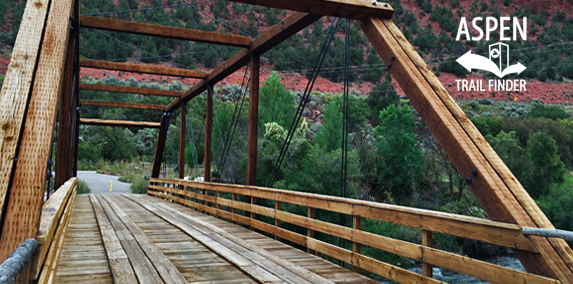Connects: Roaring Fork River, Rio Grande Trail

Historic Satank Bridge in Carbondale
Carbondale, CO – Bridge
Satank Bridge is a historic bridge built in 1900 over the Roaring Fork River that connects with the Rio Grande Trail near Carbondale, CO. The bridge is listed on the National Register of Historic Places.
More information about the Satank Bridge can be found at:
National Register of Historic Places – Satank Bridge
Wikipedia – List of Bridges on the National Register of Historic Places in Colordao
On March 5th, 1900, the Garfield County Commissioners awarded the contract to build this wagon bridge to Fred H. Bullen of the Pueblo Bridge Company. On May 12th, 1900, the actual completed bridge was accepted into the County road system by the Board of County Commissioners for a total cost of $2,345.00.
The accepted plan used the tried-and-true Pratt “through-truss” design of wood and diagonal iron rods patented by Caleb and Thomas Pratt in 1844. By 1900 this was the standard fro moderate span train and road bridges in America because it was proven to be exceptionally strong, and the trusses could be prefabricated off site. Although by 1900, iron had replaced timber in most of these bridges.
The Satank Bridge – the last of the timber truss bridges still in use in Colorado – is a testament to the durability of the design. With an overall span of 100 feet, and 14 feet of clear distance between trusses, it is the longest-span timber truss bridge in the state.
After many years of disuse, rehabilitation of this historic bridge began in September 2010. The bridge was lifted from its base and set nearby so that it could be disassembled and thoroughly evaluated by engineers. The bridge was structurally rehabilitated using replacement parts constructed of specially fabricated timber members and steel-pin connections to maintain its historical appearance. Douglas fir from Oregon was once again used fro the trusses and decking. Work on the original hand-laid red sandstone masonry abutments was limited to repointing only the joints.
Only the pieces of the original bridge that were structurally sound were retained. The drawing below delineates original and new members in the rehabilitated structure.
The new structure was installed on its historic abutments where it once again serves the community and connects the north and south banks of the Roaring Fork River.”

























